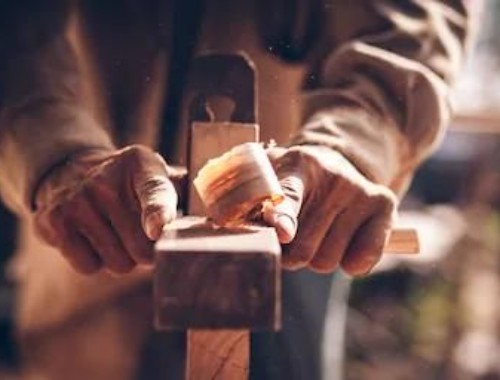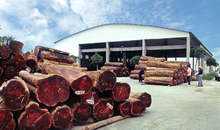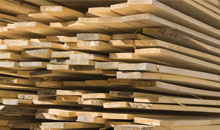Increase Yield With Reduced Checking
As one of the common drying defects of sawn lumber, end checking will cause unnecessary losses of both natural resource and productivity to manufacturers. In light of this, an innovative coating technique can become the ideal solution to tackle the problem. By Alvaro Raphael Orozco, UC Coatings
End coating freshly sawn lumber before drying is an effective and economical method of preventing end checking. Since quality and value in lumber benefits everyone, it is important to eliminate defects whenever possible. End checking is one of the most common drying defects. It is also one of the easiest to prevent.
Kiln operators work to dry lumber with the fewest defects possible. End checking problems have long been addressed in North American lumber drying manuals. USDA Handbook #528, Drying Eastern Hardwood Lumber, emphasises the importance of end coating as being extremely beneficial and capable of reducing a six to twenty percent loss of lumber.
Other sources of information, such as USDA Handbook #402, Air Drying of Lumber, notes that footage losses due to end checking and end splitting can be serious, particularly in lumber 1-1/4 inches thick or more. The extent of the damage is not always clearly apparent. As end checks open and close during drying, the defects may be hard to see at times.
According to handbook #528, end checks that are not even hairline cracks on air-dried material can extend up to 12 inches or more from the end. The importance of protecting the ends of lumber is further stated by Dr Gene Wengert in Drying Oak Lumber. End checks are often hard to detect in rough lumber, so their presence and severity will go unnoticed until the lumber is cut up. However, the damage is appreciable.

Research On End Checking
Various studies have been conducted over the years concerning end coated lumber. At Virginia Tech, Dr Wengert and Dr Fred Lamb conducted a research study to measure the effectiveness of end coating on 5/4 red oak. Two of the conclusions that were drawn from the study are, first, that end coating immediately after sawing reduces the average length of end checks by 2-1/8 inches. This is a potential increase of four percent in lumber yield. Second, a delay of three or more days in coating the ends reduces the benefits of the coating by a significant amount.
Another independent study was performed at a furniture company in North America where end coating was applied to 4/4 yellow poplar. An end coated lumber bundle and an uncoated lumber bundle of 4/4 yellow poplar were dried and evaluated. The end coated lumber had end checks in 5 of the 718 ends in the bundle, or 0.7 percent of the lumber.
The uncoated lumber had end checks in 89 of 768 ends, or 11.6 percent. The conclusion of this study was that end coating significantly reduced the occurrence of end checking. It also reduced the volume of lumber lost to end trimming. The study further pointed out that the effectiveness of the end coating would have been amplified had a refractory specie been used in the experiment.
Someone—the sawmill, the dry kiln operator, or the final user—eventually pays for the cost of this lost lumber. Furthermore, unnecessary losses are a waste of natural resources.
End checking can be an expensive defect for the lumber user. Since end coating is recognized to be an effective method of reducing end checking, the answers to six basic questions about end coating are important to consider.
1. What is end coating? End coating is the application of a coating material to seal the end grain of lumber. The three most common end coatings are hot paraffin wax, solvent-based resin sealers, and the more modern water-based wax emulsion sealers.
2. How does it work? End coating puts a moisture barrier on the ends of boards so they dry evenly from end to end. According to the USDA Forest Service Dry Kiln Operator’s Manual, end checks occur because moisture moves much faster in the longitudinal direction than in either transverse direction. Therefore, the ends of boards dry faster than the middle of the board and stresses develop at the ends. These stresses are eventually relieved by the ends of the board splitting apart.
3. What should be end coated? Any lumber specie that is prone to end checking should be coated, particularly hardwoods. Thick lumber and wide lumber are especially prone to severe checking.
4. When should end coating be applied? End coating should be applied to freshly cut, unchecked ends of wet lumber. The sooner end coating is applied after cutting, the more effective it will be.
5. How is it applied? End coatings are commonly applied by brush, roller or sprayer. Spraying equipment that is specifically designed to apply end coating is available from end coating manufacturers.
6. What is the cost of end sealing lumber? Wax emulsion coatings, for example, will cover approximately three bundles of lumber on both ends per gallon. Depending on the length of the lumber, the cost would be US$3.50-4 per thousand board feet.
End coatings are available in clear and colours. Many lumber producers end coat their lumber with a certain colour to improve the appearance of the lumber, creating a good first impression and for quality recognition. Lumber that is properly end coated is known to be more valuable to the end user.
Some other considerations regarding end coating lumber are:
•End coatings will protect lumber in the air-drying yard as well as the dry kiln. According to Agriculture Handbook #188, end checks occur in the initial stage of drying. Regardless of whether the lumber is dead stacked in a pile, sticker piled in the air drying yard, or in the dry kiln, unprotected lumber ends will check.
•Shipping uncoated lumber on an open truck can expose the boards to the most severe drying conditions possible. Freshly sawn, wet lumber typically end checks more during exposure to high winds than at any other time.
•End coating should be applied to lumber very soon after sawing to length. The sooner end coating is applied; the more effective it will be preventing end checking. Most end coatings will bond to wet lumber. Once a good end coating is dry, it will not wash off in the rain.
•Since end checking is a problem at any time of year, it is important to protect lumber ends during the colder months as well as the warmer months. Some end coatings are manufactured with antifreeze protection for easier use in the cold temperatures.
It is easy to recognise the value of end coating newly sawn lumber or having your supplying sawmill end seal the lumber you buy. Lumber that is end coated at the sawmill enhances the quality of the lumber as well as the image and reputation of the lumber producer.
For the kiln operator, end coating is a tool that can be used to help dry lumber with the fewest defects possible. For the lumber user, end coated lumber means greater yield for the lumber dollar.(fdmasia)
-

U.S. hardwood exports in 2020: Vietnam and China account for 64% of total walnut exports
-

Canadian lumber giant Weston Forest has been acquired by the Watermill Group of the United States
-

As lumber prices surge, Canadian wood said to flood U.S. market
-

Global lumber industry on pace for a second consecutive record-breaking year

 沪公网安备31010402003309号
沪公网安备31010402003309号



